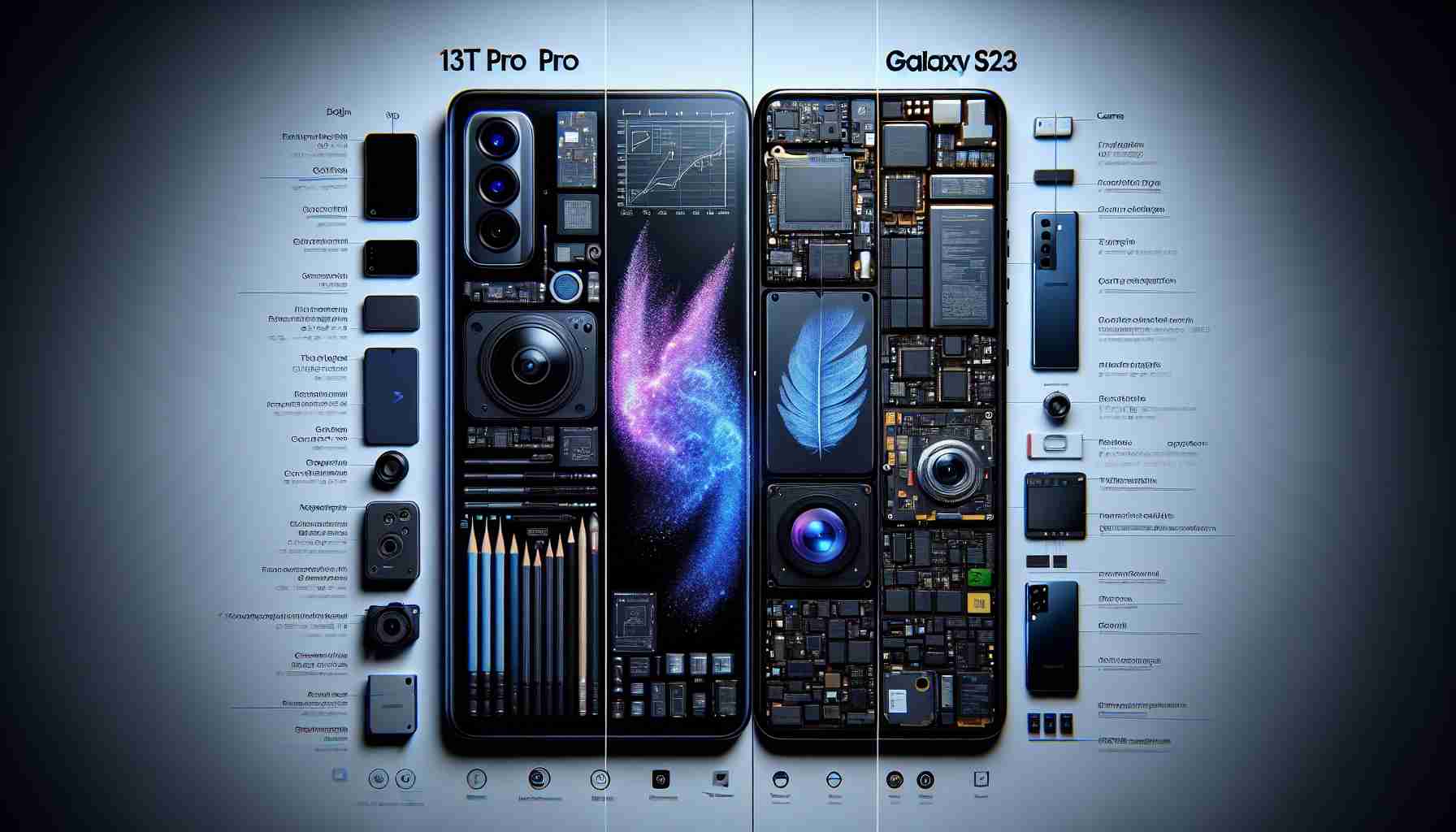In the ever-evolving landscape of flagship smartphones, two devices currently stand out: the Xiaomi 13T Pro and the Samsung Galaxy S23. Both phones cater to a similar audience, offering top-tier specifications, innovative features, and premium design. This article will delve into a detailed comparison of these two smartphones, highlighting their key features, performance, camera capabilities, and overall user experience.
Design and Build Quality
When it comes to design, the Xiaomi 13T Pro and Samsung Galaxy S23 have distinct aesthetics that reflect their respective brand identities. The Xiaomi 13T Pro sports a glass back and an aluminum frame, presenting a modern and sleek look with a slightly curved display. In contrast, the Samsung Galaxy S23 features Gorilla Glass Victus+ on both the front and back, coupled with an aluminum frame. The S23’s compact and minimalist design appeals to many users who prefer a more understated appearance. While both phones exhibit premium build quality, the choice between them largely comes down to personal preference in design language.
Display Features
Both devices boast impressive display technology. The Xiaomi 13T Pro features a 6.73-inch AMOLED display with a 120Hz refresh rate and a resolution of 3200 x 1440 pixels. Meanwhile, the Samsung Galaxy S23 comes with a 6.1-inch Dynamic AMOLED 2X display, also with a 120Hz refresh rate, but at a resolution of 2340 x 1080 pixels. This means that while the Xiaomi offers a larger and more pixel-dense screen, the S23’s display is optimized for vibrant colors and deep blacks, a signature trait of Samsung’s display technology. Users who prioritize a larger screen might gravitate towards the Xiaomi, while those who favor quality over size may prefer the S23.
Camera Capabilities
The photography aspect is where both smartphones excel. The Xiaomi 13T Pro features a triple-camera setup, including a 50MP main sensor, a 12MP ultra-wide, and a 50MP telephoto lens that supports 2x optical zoom. This setup is complemented by advanced computational photography features that enhance image quality in various scenarios.
On the other hand, the Samsung Galaxy S23 comes equipped with a triple-camera configuration as well, featuring a 50MP main sensor, a 12MP ultra-wide angle lens, and a 10MP telephoto lens with 3x optical zoom. Samsung’s image processing skills are well-known, and users can expect top-notch performance in low-light conditions, along with exceptional HDR capabilities. When it comes to video recording, both phones are capable of capturing high-resolution footage, but the S23 often has the edge with features like Super Steady mode.
Performance and Software
Under the hood, the Xiaomi 13T Pro is powered by the Qualcomm Snapdragon 8 Gen 2, paired with a generous amount of RAM (up to 12GB), ensuring smooth multitasking and gaming performance. Similarly, the Samsung Galaxy S23 also features the Snapdragon 8 Gen 2 in most regions, which means users can expect robust performance from both devices.
In terms of software, the Xiaomi 13T Pro runs on MIUI, based on Android, which offers extensive customization options but can be resource-intensive. The Galaxy S23 operates on Samsung’s One UI, which is known for its user-friendly interface and regular software updates. Users who prefer a more streamlined experience might find One UI appealing, while those who enjoy customization may favor MIUI.
Battery Life and Charging
Battery performance is another crucial factor in a smartphone’s usability. The Xiaomi 13T Pro houses a 5000mAh battery, offering solid longevity, especially under heavy usage. It supports 120W fast charging, which means it can be charged from 0 to 100% in about 19 minutes, a remarkable feat in the industry.
The Samsung Galaxy S23, in comparison, comes with a 3900mAh battery, which is slightly smaller. However, it still provides all-day usage thanks to software optimizations. It supports up to 25W wired charging and 15W wireless charging. While the battery capacity might be less than the Xiaomi, many users may find Samsung’s efficient power management ensures a satisfying daily performance.
Final Thoughts
In conclusion, both the Xiaomi 13T Pro and the Samsung Galaxy S23 offer compelling features that cater to various user preferences. The Xiaomi excels in screen size, battery charging speed, and camera versatility, making it suitable for multimedia enthusiasts. Meanwhile, the Galaxy S23 shines with its compact design, superior software experience, and robust image processing capabilities.
Ultimately, the choice between these two flagship smartphones will depend on personal priorities—whether one values display size, camera capabilities, or software experience more. Whichever you choose, both phones represent the pinnacle of smartphone technology as of now, promising users an exceptional experience.
Smartphone Selection Tips and Hacks
When it comes to choosing between flagship smartphones like the Xiaomi 13T Pro and Samsung Galaxy S23, it’s essential to consider a variety of factors that will enhance your overall experience. Here are some tips, life hacks, and interesting facts to help you make the best smartphone decision.
Assess Your Usage Needs
Before diving into features, consider what you primarily use your smartphone for. Do you frequently capture high-quality photos? Maybe you love playing graphics-intensive games or streaming videos. Assessing your needs can guide you to the right choice. For photography enthusiasts, a versatile camera setup like the one on the Xiaomi 13T Pro might be appealing, while casual users may find the S23’s camera capabilities sufficient.
Consider Software Preferences
MIUI vs. One UI: Xiaomi’s MIUI offers extensive customization options, which can be exciting for users who love to tailor their device’s appearance. However, this can sometimes lead to resource consumption. On the other hand, Samsung’s One UI provides a smoother and more intuitive overall experience, with regular updates ensuring you have the latest features. Choose the software interface that complements your preferences.
Look for Battery Optimization Features
With the Xiaomi 13T Pro’s larger battery and ultra-fast charging capabilities, you might assume it’s the clear winner in battery performance. However, the battery management software in the Samsung Galaxy S23 can often stretch its slightly smaller battery to last throughout the day. Consider how you use your device; if you’re always on-the-go, look for phones that support efficient battery management and fast charging.
Utilize Camera Modes to Enhance Your Photography
Both phones come with specialized camera modes that can significantly improve your photography. Explore features like night mode, portrait modes, and macro photography settings. Understanding how to use these modes can enhance the quality of your pictures, regardless of the smartphone you select.
Regular Maintenance for Optimal Performance
To keep your smartphone running smoothly, don’t forget to perform regular maintenance, such as clearing the cache and uninstalling unused apps. Both MIUI and One UI provide tools to help optimize performance. Regular updates also improve security and add new features, so always ensure your device is up to date.
Explore Third-Party Accessories
Both smartphones have a wealth of third-party accessories available. From protective cases to camera lenses and fast chargers, investing in accessories can enhance your device’s usability and lifespan. Online platforms often feature reviews that highlight the best options available for your chosen smartphone model.
Interesting Fact: Price vs. Features
When comparing flagship models, consider how much you’re paying for additional features. Sometimes, more affordable models like the Xiaomi 13T Pro deliver similar or superior features at a lower price than competitors like the Samsung Galaxy S23. Always evaluate your options before making a purchase.
Conclusion
Ultimately, knowing which smartphone fits your lifestyle is key. Whether you lean towards the Xiaomi 13T Pro’s impressive charging speed and camera versatility or the Samsung Galaxy S23’s user-friendly software and design, understanding these tips and hacks can enhance your user experience.
For more smartphone insights and updates, visit TechRadar.


















